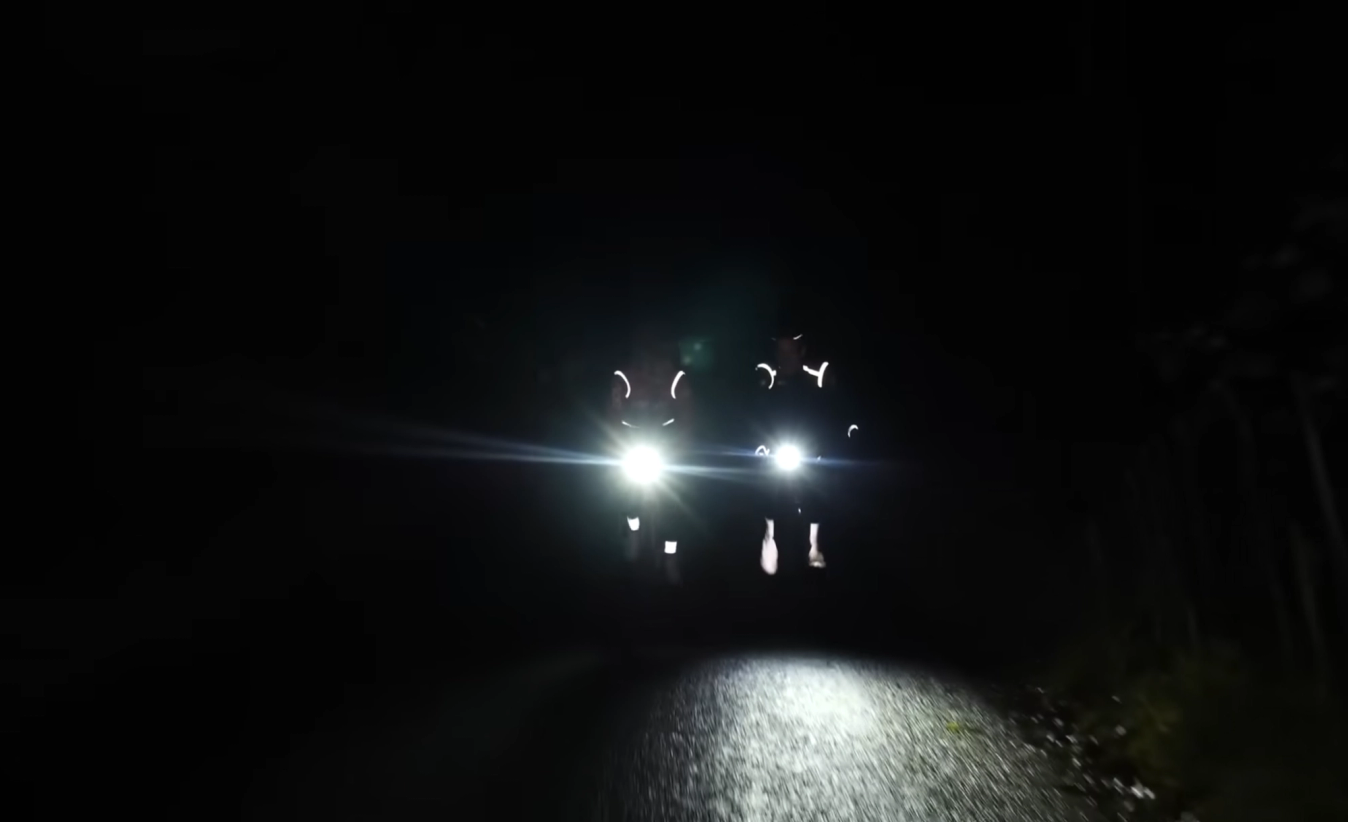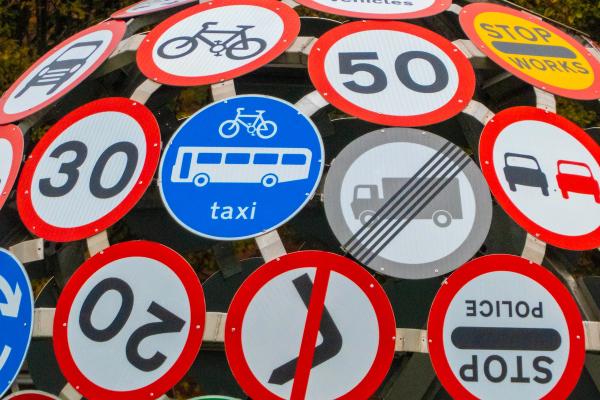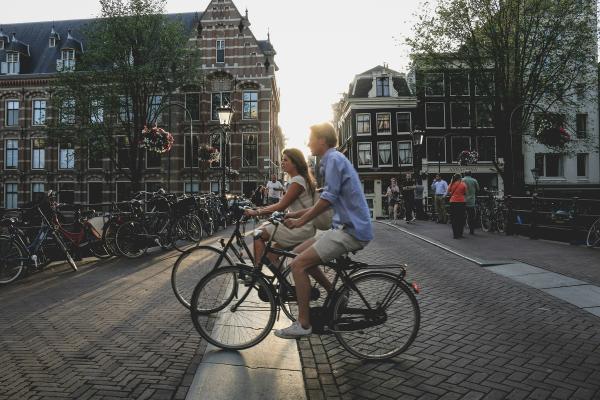Is high-visibility clothing effective for cyclists? Debunking myths and misconceptions
Simon Richardson explores the science behind hi-vis clothing and finds out what combination of kit might help make us safer on the roads
GCN
The GCN team
High-visibility clothing has long been touted as a safety measure for cyclists. Common sense tells us that by making ourselves more visible to motorists, we should reduce the risk of being involved in a collision. But is that really the case?
By speaking to Professor Joanne Wood, an expert in vision science, and Professor Ian Walker, an expert in psychology, we’ve got to grips with the science behind hi-vis. Ultimately, a combination of fluorescent colours and reflective fabrics, if worn in the right way, will make you more visible to drivers.
However, the researchers are torn about whether being easier to spot on the roads will actually make you safer. In fact, some would even go as far as to argue that hi-vis clothing makes cyclists as a whole less safe, as it brings with it an insinuation that collisions between cars and bicycles happen because of what the cyclist has chosen to wear, not whether the driver was driving safely.
Read more: What causes road rage between drivers and cyclists? We asked a transport historian
Does hi-vis clothing make you more visible?

© GCN
Does hi-vis make you more visible?
To answer that question, we have to first understand how our vision works, as Professor Joanne Wood explains.
“Well, the first thing is that we think we can see very well everywhere, but in fact, it's only about the central two degrees of our vision that's got very finely detailed vision and can see colour,” Wood tells us. “So, the central part of your vision is a bit that actually sees detail. So, the rest of your vision can detect movement, but you don't see detail. So, in order to see detail, you have to look at something. So, you can have your attention attracted, for example, with my hands in the air. But to actually see my fingers, I actually have to have to look at them.
“Our visual system is constantly scanning, and as we cycle or drive, we're scanning the road ahead,” Wood goes on to explain. “We're using that central detailed vision, but if we have something in the edge of our vision or side vision that attracts our attention, then we will automatically look at it. So, our visual system is constantly scanning. We're constantly, as you know, scanning the road system to be able to detect movement or bright things. And it's only when we look in our central vision that we can actually tell that something is a cyclist or it's a cone, for example. So, we can differentiate the detail.”
Visibility vs conspicuity
Wood says that it’s vital to understand that visibility is not the same as ‘conspicuity’.
”If something's visible, it means you can detect it. But if something's conspicuous, it kind of grabs or attracts your attention.
“So, if we think of the road situation, a driver can be driving along the road and they can see something ahead and it could be a reflective bollard or a reflective sign or it could be a bicyclist. But they don't know what it is. They don't know whether they've got to avoid it or not.
“Whereas if something's conspicuous, it attracts their attention, even if they weren't pre-warned, and they know that they've got to do something about it. So, it sort of gives them a cue that there's something ahead in the road system that they need to potentially take some action around.”
In short, if a driver doesn’t look directly at a cyclist, they might not be able to tell exactly what it is they have seen. Hi-vis makes cyclists conspicuous, meaning that it naturally draws the attention of drivers. Once a driver has looked directly at a cyclist, they will be able to use that detailed central part of their vision to identify what they’ve seen.
Fluorescent vs reflective

© GCN
Fluorescent clothing works in the day, but not at night
Hi-vis can make you more conspicuous, then, but it’s not as simple as chucking on a fluorescent vest no matter what the conditions, as Wood explains.
“Certain types of clothing are much more effective in the day. So, fluorescent clothing is effective in the day but isn't effective at night. So, if you're wearing fluorescent clothing in the day, obviously, fluorescent materials convert the UV from sunlight, which is invisible, into visible and reflected light, so you sort of have this pop of colour. But in the nighttime, because there's no sunlight and there's not very much UV in headlights or street lighting, fluorescent materials don't pop out. There's not that colour pop.
“But with retroreflective materials, the light goes in, and it's reflected straight into the direction of the viewer. So, if you're wearing retroreflective materials at night, then you'll be seen as something bright. So, if you want to be detected, visible and conspicuous, you need to wear fluorescent clothing in the day but you need to wear retro reflective clothing at nighttime. So, fluorescent clothing on its own without any retro reflective elements won't work.”
It’s crucial to note, then, that fluorescent clothing does not work at night. At night, you need to be reflective.
"If you want to be detected, visible and conspicuous, you need to wear fluorescent clothing in the day but you need to wear retro reflective clothing at nighttime. So, fluorescent clothing on its own without any retro reflective elements won't work.”
Most crashes do not happen because drivers cannot see cyclists
Even if hi-vis clothing can increase our conspicuity, that doesn’t necessarily mean that it reduces the likelihood that a driver will crash into you. As Professor Ian Walker explains, there are three types of collision between cars and bicycles, and hi-vis only matters in one of them:
“There are going to be some collisions where the driver just didn't see the rider, and if they had seen them, it wouldn't have happened, and high-visibility might well be useful there. But there's also going to be collisions where the driver did see you, but misjudged the manoeuvre, like a bad overtaking manoeuvre or something like that. And then there will also be a small number of collisions where the driver saw you and deliberately hit you, and high-visibility is definitely not going to help in those circumstances.
“So, the real question becomes how many of these collisions are the first type where the driver just didn't see you, and how many of the second type where the driver saw you but fluffed the driving manoeuvre?
“There is a bit of evidence on this. There were researchers from Nottingham a few years ago who went to a hospital emergency room and essentially said, ‘Well, look, if the collisions are the first type, we wouldn't see people coming in wearing hi-vis.’ But what they found was that people coming into the hospital after cycling collisions were wearing hi-vis or not wearing hi-vis pretty much the same proportions as out on the street, which suggests that wearing it wasn't really reducing the probability of collisions at all.”
In the study, the researchers concluded that, “conspicuity aids may not be effective in reducing collision crash risk for cyclists in highly-motorised environments when used in the absence of other bicycle crash prevention measures such as increased segregation or lower motor vehicle speeds.”
These results might have been skewed by riders mistakenly wearing fluorescent clothing at night
A similar study from Canada found similar results, but before concluding that hi-vis did not impact collision risk, they looked a little closer at the data. They realised that the results were being impacted by people mistakenly wearing fluoro clothing at night instead of retroreflective. By separating collisions that occurred in the day and at night, they revealed that during the day, fluorescent clothing did reduce the chances of a collision.
Another study into this topic found the same thing. The research, which was the largest study of its kind, with 7,000 participants, found that cyclists wearing a jacket with a mixture of fluoro and retroreflective panels reduced their risk of a collision by a remarkable 55%. However, it’s not without its critics — the participants knew they were taking part, which could have influenced their riding behaviour.
If hi-vis really made us safer, that would be obvious
The research doesn’t give us the clear answer that we’re looking for, then. But as Walker says, if hi-vis was substantially safer, it would be hard to ignore:
“If it made a really substantial difference — I'm not ruling out the idea that high-vis might make a small difference — but if it made a really substantial difference, that would just be obvious by now. People wearing it would not get hurt and people not wearing it would get hurt. It's what we'd call a ‘naked eye effect’ in the research world; you'd just be able to see it if it was really substantial. So, if it does have an effect, and maybe it does, it's not going to be a massive one because we would have known that just from observation by now.
“If it made a really substantial difference — I'm not ruling out the idea that high-vis might make a small difference — but if it made a really substantial difference, that would just be obvious by now."
Victim blaming: does hi-vis take accountability away from drivers?

© GCN
Some say hi-vis puts too much accountability on the cyclist to stay safe
Like many safety topics within cycling, hi-vis can also become part of victim blaming. That means that when a collision happens, instead of asking why a driver hit a cyclist, people ask what the cyclist was wearing. Professor Walker explains:
“One other thing that I often think about when I'm riding is, let's say you've been out for half an hour or an hour on the bike. How many drivers have successfully gone past you or come in front of you at that point without hitting you? And often it will be hundreds of drivers who have successfully interacted with you.
“So something I often think is, well, if someone hit me now, the question would almost certainly be: ‘What was Ian doing? What was Ian wearing?’ Whereas really, the question should be: ‘Why did this driver hit me when all those others successfully didn't?’ And it's an interesting one when it comes to the hi-vis discussion: why is the focus so much on the person who gets hit as opposed to the one driver out of potentially hundreds who's done something different to all the rest?”
"Why is the focus so much on the person who gets hit as opposed to the one driver out of potentially hundreds who's done something different to all the rest?”
Even so, hi-vis can still improve your safety
Victim blaming is a problem, but that doesn’t necessarily mean that we have to put ourselves at a greater risk just to prove a point, as Professor Wood explains:
“A lot of feedback about victim blaming is that it's not the cyclist’s responsibility. The reality is that it’s everybody's responsibility to try and make sure that cyclists are safe on the road system. So, I agree, I wish that everybody didn't have to do that, but I think realistically, cyclists don't come out of crashes well, and we know that. Their fatality rates are high, but even if they don't have a fatality, the severity of injuries is so high that I think anybody who's doing a lot, is exposed on the road systems, should be wearing something fluorescent and retroreflective.”
Wearing hi-vis clothing will make you more conspicuous on the road. It might not make a difference, but it could well reduce the chances of a motorist colliding with you. Perhaps, then, wearing hi-vis is like wearing a helmet: there is evidence to suggest they don’t make you safer, but you might as well wear one just in case.
It doesn’t take much to increase your conspicuity

© GCN
Reflective strips light up at night
Thankfully, you can increase your conspicuity without dressing in head-to-toe neon. As Professor Wood explains, by taking advantage of the human eye’s natural attraction to movement, you can increase conspicuity with a few careful touches.
The visual system is very sensitive, so you only need a certain amount of material, and as long as it's moving on your movable joints.
“A lot of people think, ‘Oh, I've got to have 100 lights or I've got to have this huge big yellow jacket or I've got to do all this stuff.’ The visual system is very sensitive, so you only need a certain amount of material, and as long as it's moving on your movable joints. So as observers or humans, we're very sensitive to biological motion, and that's true for pedestrians as well.
“So, pedestrians, if they wear markers on their wrists, elbows, knees, ankles, and also on their hips, they'll be very obviously a person because the visual system is sort of tuned to movement and we can recognise that very easily that a person is present.
“And in studies we've done, we've shown that if you add reflectors on the knees and ankles and add that to a vest, it makes a huge difference to the distance at which a driver first recognises that a person is present. Biological motion is very strong for pedestrians, that is, wear your retroreflective material on your movable joints. And for cyclists, it's particularly the case for ankles and knees."
Staying safe with hi-vis clothing
There is a whole load of misinformation out there, but if you want to wear hi-vis clothing to feel safer on the roads, remember: wear bright clothes in the day, and wear reflective clothing at night. And for the greatest conspicuity, make sure the moving parts of your body are hi-vis, specifically your feet, knees and ankles.
Keep that point about victim blaming in mind, too. As cyclists, it's our responsibility to try and correct this car-centric culture where we can. Rounding on another cyclist who might not be wearing high-vis is absolutely not the answer. It feeds into this rhetoric that it's down to us to protect ourselves when in reality, it's just one component of a much bigger picture.
Ultimately, however dangerous you might feel cycling is, and however dangerous other people can make you feel that cycling is, keep in mind that the statistics show that cycling is much safer than a lot of us might think.
Finally, it's imperative to remember that sitting in our cars does not make us safer either, no matter how it might feel. Being sedentary erodes your long-term health to the extent where you are actually far safer out on the roads getting exercise and riding your bike.
For more on urban cycling and safety, look at our general news, tech features and lifestyle section.









.jpg?w=600&auto=format)